Swimming not only forms one of the best sport across the world, but also the best recreational activity.
In most cases, people take it as a leisure activity rather than a sport.
Probably because not all people have mastered the art of swimming or generally are not interested in swimming.
However, before considering swimming, you need to have a swimming pool in mind.
You might choose to own one at the comfort of your premises or otherwise choose to use commercial swimming pools.
Either way, you will enjoy swimming. However, owning a swimming pool will give you much convenience at your disposal.
In this guide, I will explain to you how you can build your own swimming pool step by step.
But first, let’s get to know what we mean by a swimming pool.
What is a Swimming Pool?
A swimming pool is a structure dug in the ground and filled with water for the purposes of swimming activities.
Swimming pools not only offer leisure, but also come along with a lot of health benefits.
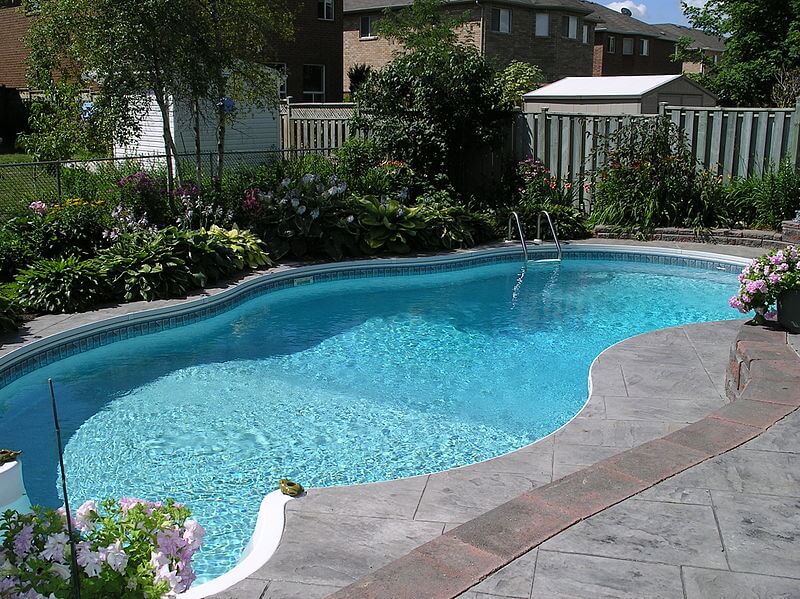
Swimming pool
Additionally, there’s no doubt that swimming pools not only add beauty to your premises, but also will increase the value of your property.
To learn more, keep reading.
Why You Need a Pool
There are quite a number of reasons why you need a swimming pool.
They include:
Ø Healthy light exercise
Research has proven that swimming provides a cardiovascular workout which in turn burns calories in your body.
This is a recommendable form of exercise as there is minimum risk of injury compared to gym workouts.
Ø A place for Family fun and bonding
When you own a pool, you are actually creating an entertainment joint where your children and family can bond while enjoying pool activities.
You can choose to invite friends to come over for poolside barbeques and pool activities which alternatively build lasting memories.
Ø Relaxation
After a long day of work, taking a quick dip in your swimming pool will help you refresh and unwind at the same time giving you a relaxation feeling.
Ø Creating a touch of tranquility at home
We have different pool designs, some of which create a resort feel at the comfort of your home.
Take for instance, a pool with waterfalls, vanishing edges and other captivating features.
Such pools will not only provide calmness for meditation, but also offer you with a paradise look in your backyard.
I will explain more on pool designs later in this guide, just stay with me to learn more.
Ø Increase value of property
As I mentioned earlier in this guide, swimming pools increase the value of your property.
By this I mean, a homeowner with a pool will attract more prospective buyers wishing to purchase the home as compared to a home with no pool.
In short, the pool will enhance faster sale of your property.
Generally, swimming pools offer long lasting fun which you will enjoy with your family and friends for years.
But first, you need to have a clear budget before thinking of starting a swimming pool construction.
Budget for the Pool Construction Cost
There are a number of things you need to factor in before you begin constructing your swimming pool.
Here, I will walk you through a few critical aspects.
They include:

Constructing a swimming pool – Photo courtesy: Simple Pool Tips
Estimate Cost of Constructing a Swimming Pool
Basically, we have two types of swimming pools. The in-ground and above ground pool.
Mainly, your cost budget will vary depending on the type of pool.
Besides that, custom features, types of materials used, size and location will add up anywhere from $1100 to $9000 to your total budget.
However, a swimming pool installation cost will range from as low as $6500 way up to $35000 or more depending on various factors that I will explain to you.
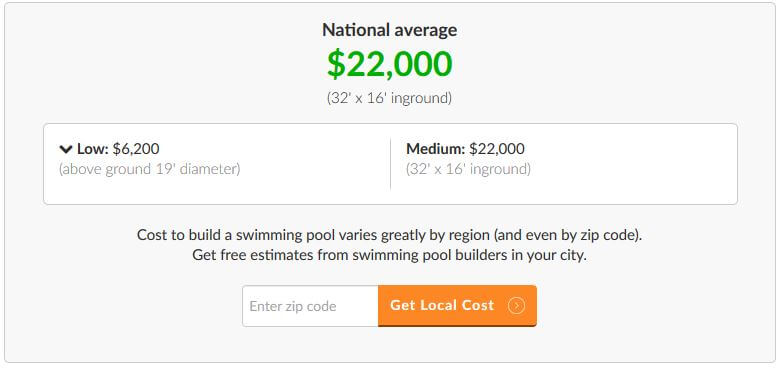
Cost of constructing a swimming pool – Photo courtesy: FIXR
Building an in ground pool is considered expensive.
Reason being, site preparation is expansive and needs expensive materials to construct.
Although above ground pools are less expensive, most people find them un attractive.
So, what’s the bottom line here?
Despite the fact that above ground pools are less expensive, they will not offer the same value to your home as it would with in ground pools.
It’s also important to consider that in-ground pools can be made to suit your preferences serving you with a wide variety of features.
Factors Determining Cost of Swimming Pool Construction
Below are some of the key elements that affect the cost of constructing a swimming pool.
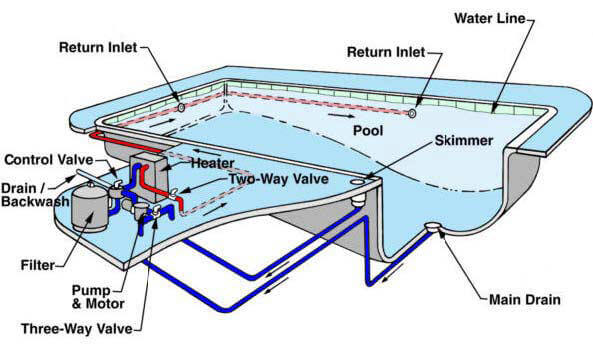
Swimming pool structure – Photo courtesy: GREGABBOTT
· Materials Used
We have several materials which you can use in pool construction.
These materials are not limited to fiberglass, concrete, vinyl, pool enclosures among others.
Before making any purchases, it’s better to weigh the costs of each material.
As compared to vinyl and concrete, fiberglass stands out, to be the least expensive.
But this is what I have to say, concrete will be the best material for better investment in terms of maintenance and durability.
· Size of the swimming pool
The bigger the pool, the higher the cost of swimming pool construction.
Why?
You will use more materials when constructing a larger pool as compared to a small sized one
· Pool depth
There’s no doubt that deeper pools cost more than shallow ones.
Reason being, they not only consume more materials, but also more labour is needed owing to the additional digging.
· Type of pool
We have different types of pools which come in diverse designs.
Pools that are designed to accommodate features such as waterfalls, pool enclosures, vanishing edges are bound to be more expensive to build due to the additional costs.
To add to that, in-ground pools cost more than above ground pools.
I will explain more about these two types of pools later in this guide, keep reading.
· Location of the pool
The location of your pool will determine the permit cost, size of equipment to be used and energy costs.
Building a pool in a location that has no electricity will require you to spend more on energy costs.
It’s important to know that permit cost vary from one city to another.
· Pool accessories
As I mentioned earlier, additional pool features will shoot the cost of your swimming pool construction.
Take for instance, installing waterfalls and pool enclosures.
Such amenities will consume a lot of resources not only to install, but also to maintain.
With this information, you are now set to come up with your desired swimming pool design.
Choose a Swimming Pool Design
Swimming pool design is yet another critical aspect you should consider when constructing a swimming pool.
Below are some of the main things you should do:

Different shapes of swimming pools
· Hire Engineers and Technicians to Help in Pool design
Hiring skilled labor to help in designing your pool will assure you better quality.
Why am I saying so?
Engineers and technicians are specifically trained in such fields, making them well oriented in designing different types of pools.
· Shape and Size of Swimming Pools
Swimming pools come in distinct shapes and sizes for both homeowners and commercial premises.
In this section, I will inform you on the different types of pools that you need to be aware of before beginning your swimming pool construction.
Basically, the following are the top most constructed pools.
- Geometric pools
- Rectangular pools
- Circular Pools
- Oval Pools
- Kidney Pools
- Infinity Pools
- L-shaped Pools
i. Geometric Pools
As the name suggests, geometric pools are normally built on some geometry knowledge or rather mathematical features.
Having incorporated squares, circles, rectangles, triangles and other well designed shapes, these pools instantly become attractive.
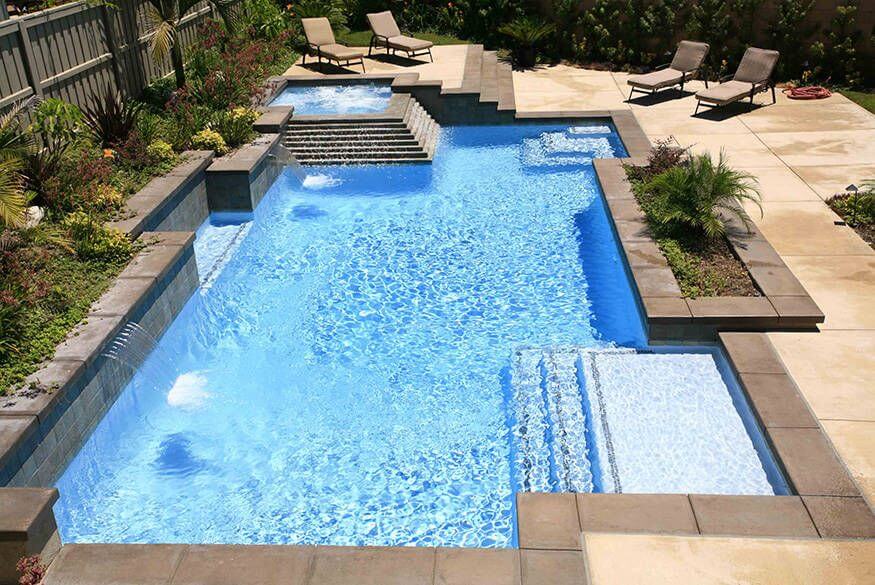
Geometric swimming pool
That is not enough, geometric pools can as well be designed to accommodate special features such as waterfalls, fountain bubblers, vanishing edges and spillways.
Such features make it quite suitable for modern properties as well as desert environments.
ii. Rectangular Pools
Rectangular pools form one of the most constructed pools worldwide.
These particular pools possess a lot of benefits not limited to;
- Saving pool space
- Facilitating swimming in laps
- Easy to build a pool cover on due to its formality
Besides all these benefits, one thing you need to know is that rectangular pools cost more than curved pools due to their enlarged perimeter footage.
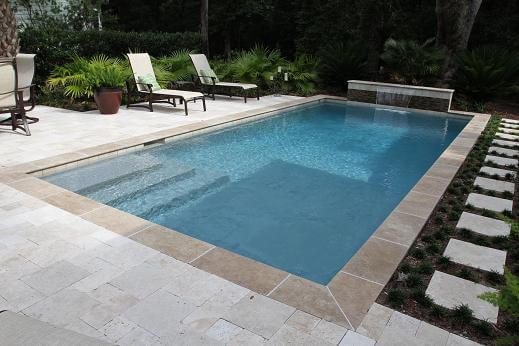
Rectangular swimming pool
iii. Circular Pools
Circular pools have equal distance from the centre to the edges round the pool.
Such pools occupy more space as compared to rectangular pools.

Circular swimming pool
Aside that, it’s easy to install pool enclosures on circular pools due to their uniform shape.
iv. Oval Pools
Oval pool becomes the right choice when space is a limited factor.
In addition, you can design such pools to have a separate baby pool and the adult swimming area due to its oval shape.
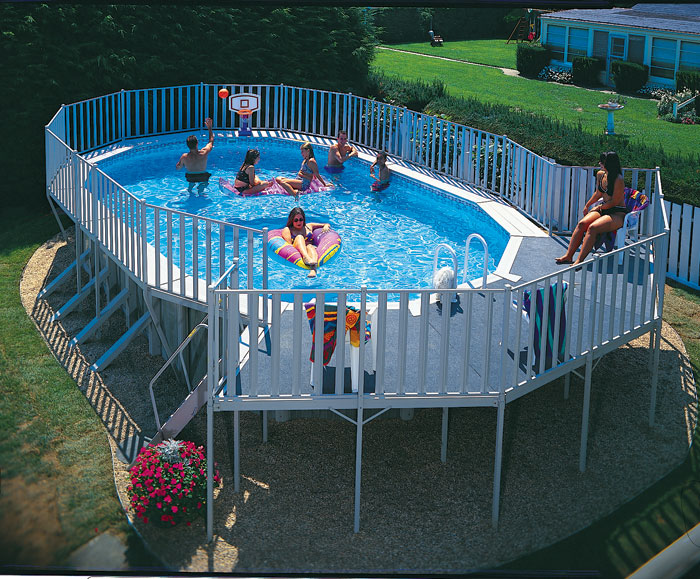
Oval swimming pool
Its long and narrow shape facilitates swimming in laps.
These make it one of the best pools to construct at less costs.
v. Kidney Pools
Most people confuse a kidney shaped pool with an oval shaped one.
The major difference between these two is that a kidney shaped pool has a curving at the central part while an oval one doesn’t.

I hope this gives you a picture of what I’m trying to say.
vi. Infinity Pools
Infinity pools are one of the most attractive pools that you can choose to own in your yard.
Such pools have vanished edges which flirter your mind into thinking that the pool ends at a particular edge.
However, this is not normally the case.
Instead, water from the pool flows down through a canal and back to the pool.
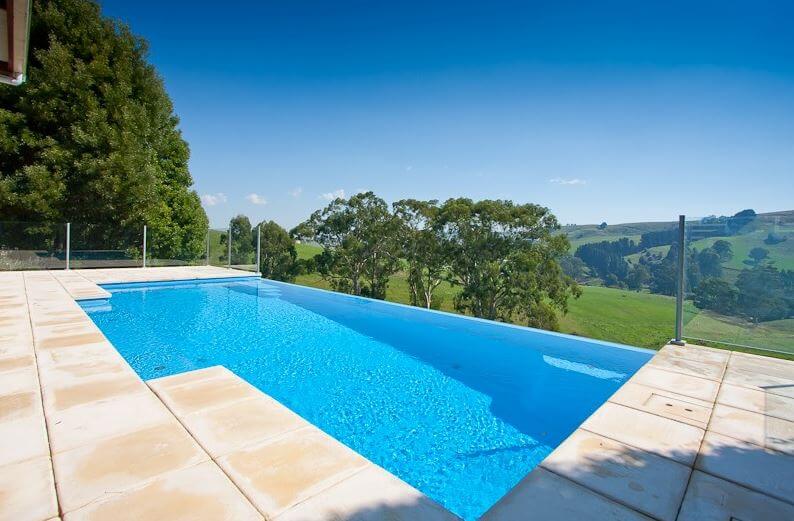
Infinity swimming pool
The vanishing edges provide a great view of the scenery across the pool be it vegetation or an ocean.
vii. L-shaped Pool
As the name suggests, such pools resemble the letter “L”.
Its shape gives you an option for having a deep side of the pool as well as the shallow side to suit children.
On the other hand, we have the lazy L-shaped pool which has a shorter extension as compared to the L-shaped one.
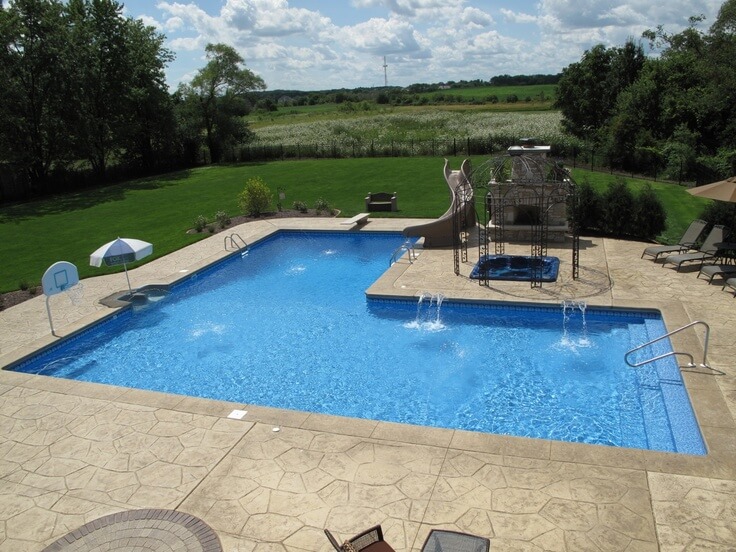
L shaped swimming pool
However, this type of pool is not common with most home owners reason being it consumes a lot of space and shoots up the budget due to its extensive perimeter footage.
In-ground vs. Above Ground Swimming Pool
Swimming pools are majorly divided into two types;
1. In-ground swimming pools
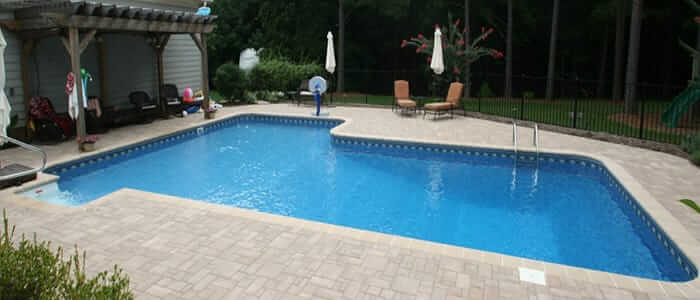
In ground swimming pool
2. Above ground swimming pools
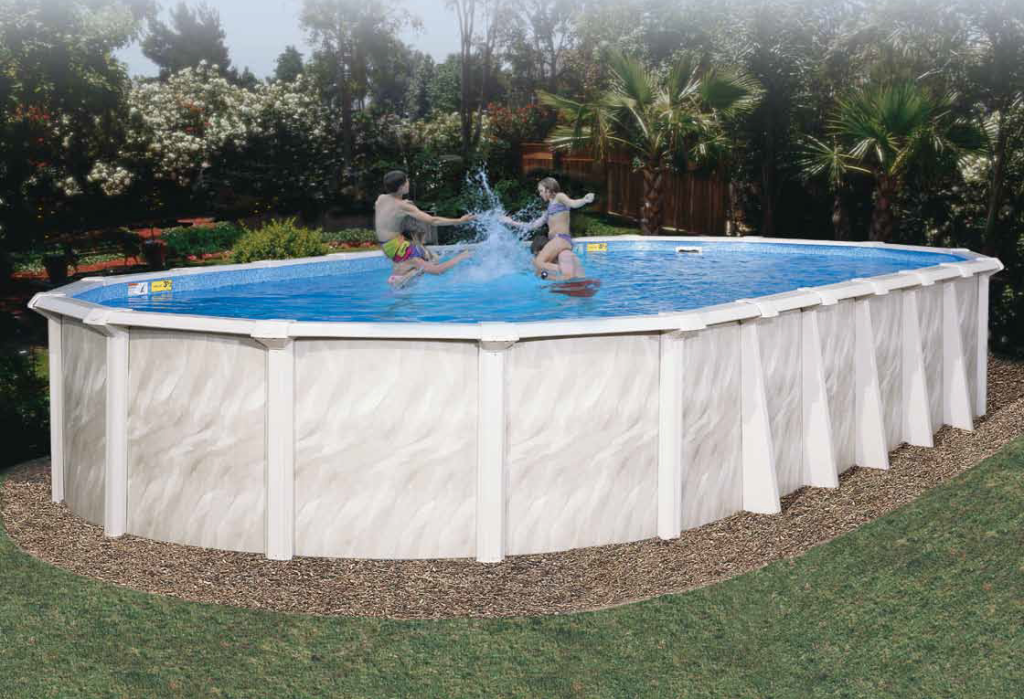
Above ground swimming pool
· Design
As the name suggests, in-ground swimming pools are built into the ground, meaning, they are not found on the surface of the ground.
On the other hand, above ground pools are constructed on the surface of the ground.
In other words, they are above the ground.
· Types of pools and materials
We have different types of in-ground pools not limited to vinyl, fiberglass or concrete depending on your preference.
Under other conditions, above ground pools are commonly constructed from a range of materials including vinyl, aluminum and metal among others.
I will explain more on swimming pool materials, just stay with me.
· Convenience
In-ground pools are suitable for homeowners residing in warmer climates reason being once installed, they cannot be moved.
As compared to in-ground pools, above ground pools can be moved if necessary.
This makes them the best option for homeowners residing in places where warmer climates are experienced for a short while.
· Lifespan
In- ground pools can last up to 70 years or more if well built and maintained.
However, above ground pools last up to 26 years if well maintained.
· Cost
As I mentioned earlier, above ground pools are much, much cheaper as compared to in-ground pools.
How much cheaper?
Well, you can purchase the cheapest at around $500 while the highest quality pools costing a bit higher.
Swimming Pool Materials- Fiberglass, Vinyl or Concrete
There are several types of swimming pool materials including;
- Fiberglass
- Vinyl
- Concrete
- Gunite
- Pebble Tiles
However, in this guide I will major on the three commonly used types.
· Fiberglass
If you are thinking of putting up a speedy pool design, then fiberglass is the best material to use.
Hiring professionals to construct your pool will take you as shorter as three weeks.
As if that’s not enough, fiberglass has low maintenance as well as a longer lifespan.

Fiberglass swimming pool
Unfortunately, pool designs made of fiberglass have limited shapes and sizes to choose from.
Secondly, fiberglass is limited to being no wider than 16 feet.
· Vinyl
Vinyl is not only the most economical material, but also the best when it comes to pool customization.
Additionally, it has a low maintenance cost due to its non-porous surface which prevents growth of algae.
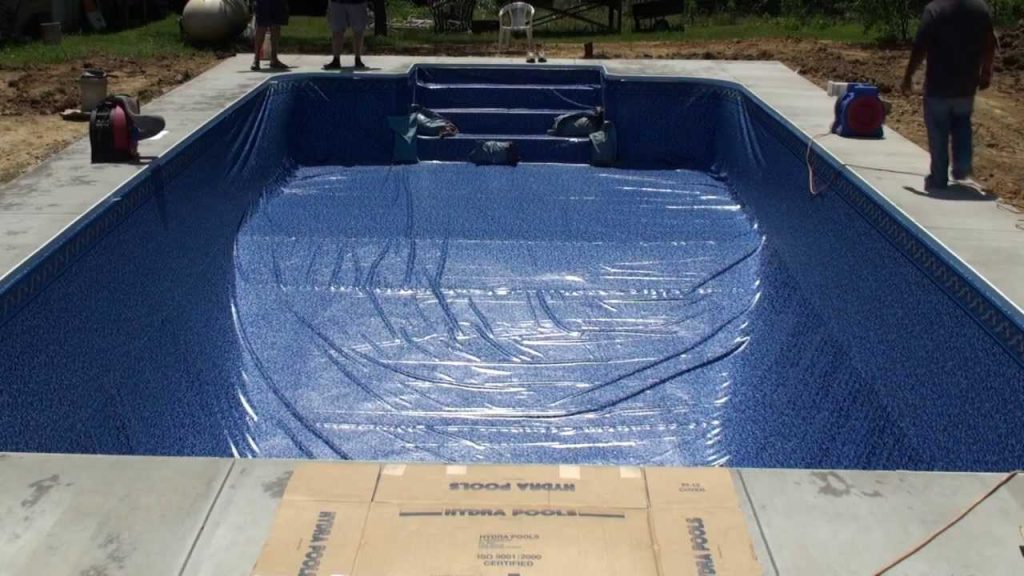
Vinyl in swimming pool
The downside of this material is that it’s valued lower when it comes to selling property.
· Concrete
I would recommend you to use concrete among other materials.
Why?
It can easily be customized into different shapes and designs to suit your preferences.
Although it takes longer to construct, the outcome is always perfect.
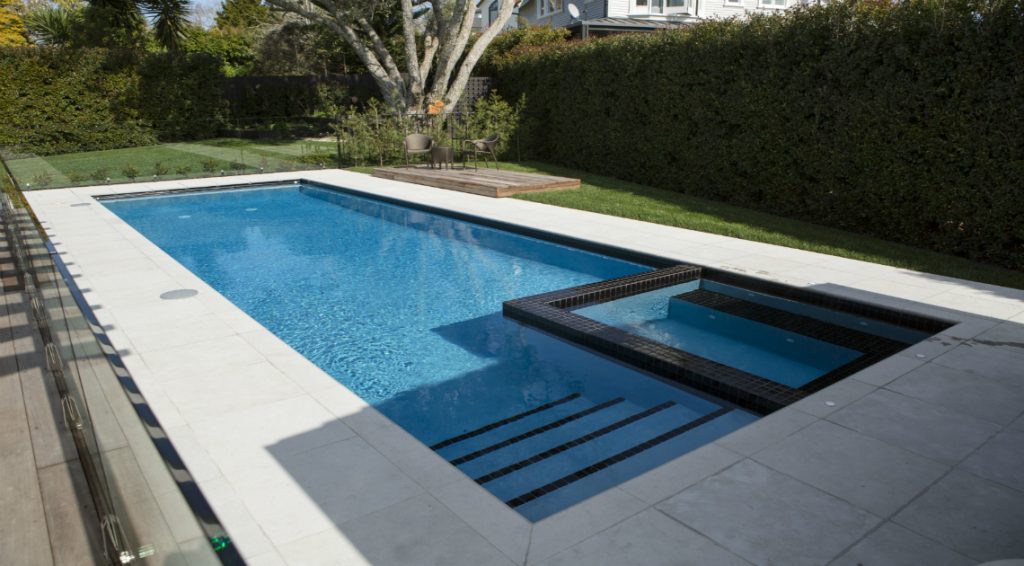
Concrete swimming pool
The downside of this material is that it will require renovation every 10-20 years, which could be a bit pricey.
To add on that, regular maintenance is needed as its surface facilitates growth of algae.
List of Tools and Equipment for Swimming Pool Construction
When building swimming pool, a lot of equipment are used.
Some of the most essential include;
- Pool pump
A pool pump ensures continuous circulation of water in the swimming pool.
- Filter
Water flowing from drains are circulated through the filter and clean water is directed back to the pool.
Normally, filters are filled with sand so as to enable water filtration.
- Return outlets
They are fixed on to the walls of the pool for the purpose of returning heated, clean water back into the pool.
- Skimmers
Skimmers help in removing debris that floats on the pool surface.
- Drain pipe
Drains are normally fixed in the waste water drain system as its purpose is to backwash the filter.
- Water chlorinator
A water chlorinator ensures regulated supply of chlorine into the water to kill bacteria.
- Pool covers
They are essential for general protection of the pool.
- Ladder
Ladders facilitate easy movement in and out of the pool by the pool users.
- Entry rail
It’s essential for offering support when entering or getting out of the pool.
Nevertheless, you will also need equipment’s for pool maintenance after the construction.
Equipment and Accessories for the Pool
Here are some of the main accessories you’ll need:
- Skimmers and cleaning equipment
They are used for cleaning the swimming pool.
- Alarms and safety equipment
This may include door and gate alarms, in-ground alarms, above ground alarms among others.
- Pool lights
Pool lights not only create an attractive ambience around your pool area but also enables swimming at night.
- Pool Chemicals
Pool chemicals such as chlorine are used to clean the pool water by killing bacteria.
Getting Approval from Relevant Authorities
Before thinking of starting your pool constructing, you first need to get approval from relevant authorities.
This will involve acquiring a swimming pool permit.
A swimming pool permit will ensure that your pool meets the required standards.

Approval
The officer concerned will pay a visit to the site and assess whether the site is appropriate for a pool construction.
Afterwards, he or she gives you the permit having proven that everything is appropriate.
However, it’s important to know that permit costs vary from one city to another.
Building a Swimming Pool (Step-by-step Process)
Now, once you have everything in place, this is how you will go about the swimming pool construction process.
Here are two videos that will also help you understand this process:
· Above Ground Swimming Pool Construction
· In ground swimming pool construction
I. Assess the Pool Building Site
Before you start constructing your pool, it’s important to consider factors such as type of soil on the site as well as the topography of the area.
Very sandy, unstable soil or rocky places will not only make it difficult, but also costly for your pool construction.
In addition, a soil test is done to ensure that it’s a suitable location for pool construction.
Note: Swimming pools are best built on level surfaces.
II. Excavate the Area, Level and Grade the Pool Installation Site
First, the pool constructor has to determine the length, width and pool depth required before beginning the excavation process.
Excavation entails preparing the desired site by digging out soil from the ground.
At this point, you will require heavy machineries for excavating such as an excavator.
This is where the actual construction begins.
Note: When levelling the site, it’s much easier if you dig out the higher side and level it with the lowest ground than the vice versa.
III. Prepare the Base of the Pool
At this stage is where you need to prepare the floor of your pool.
Given that the pool floor is not flat, I would recommend you to fill the surface with a layer of sand just so as to provide a flat base to work with.
Secondly, set up screed bars to guide you through the sloppy parts of the dug hole.
Having adhered to this, screeding becomes a smooth process.
IV. Put Plumbing and Electrical Systems in Place
A plumbing system will play a significant role in the functioning of your swimming pool.
Why?
This particular system will ensure continuous circulation of water in and out of your pool.
Normally, we have suction pipes which bring water from the pool and return pipes that take water back to the pool.
On the other hand, pool valves are used to control the direction of water to and from the pool.
All these equipment are well fitted in the concrete pool walls, making them invisible during swimming activities.
Having installed the plumbing system, it’s now time to put the electrical system in place.
This ensures proper functioning of equipment such as pool heaters, pool lighting, pumps together with other equipment that requires electricity.
It’s important to note that professionals should perform this process as it can pose a danger to potential swimmers if not fitted correctly.
V. Build the Entire Structure of the Swimming pool
Your pool starts coming to life at this stage as you will build the actual floor and walls by plastering the surfaces.
By this I mean, mix sand and cement using water proportionally and pour onto the floor to make it smooth.
Repeat the same process on the pool walls using concrete of cinder blocks until you reach the desired level.
I would recommend you to employ professionals to work on this job to avoid any accidents later on such as collapsing.
Allow the concrete to settle for about 4 weeks.
VI. Do the Final Finishing of the Pool
At this point, your pool is close to getting ready.
Given that almost everything is in place, now it’s the best time to fill your pool with water and carefully check whether there are any leakages.
Also, test the plumbing and electrical systems and ensure they are functioning as desired.
VII. Install a Swimming Pool Enclosure
A pool enclosure generally protects your pool from accidents, harsh weather conditions and ensures the cleanliness of your pool.
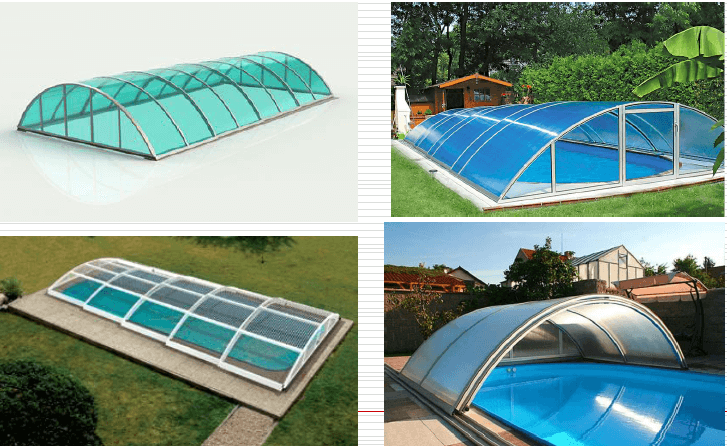
Swimming pool enclosure
I would recommend you to use a polycarbonate pool enclosure as it’s much durable.
Additionally, you can choose to install a fixed or retractable pool enclosure or even a high or low profile as per your preference.
Conclusion
With this information, you are now enlightened about the various key factors to consider before your pool construction as well as the actual building.
In short, it’s now easier for you to build your pool as per your budget and design preference.

